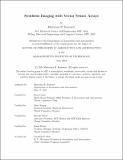Synthesis Imaging with Vector Sensor Arrays
Author(s)
Kononov, Ekaterina R.
DownloadThesis PDF (4.460Mb)
Advisor
Cahoy, Kerri
Knapp, Mary
Masui, Kiyoshi
Terms of use
Metadata
Show full item recordAbstract
Radio astronomy observations at frequencies below 10 MHz could provide valuable science, such as measuring the cosmic dark age signal in the redshifted 21-cm hydrogen absorption line, detecting exoplanetary auroral emissions which lead to inferences about magnetic fields and atmospheres, and characterizing the effects of solar wind and coronal mass ejections on the magnetospheres of solar system planets. Despite their value, few measurements in the sub-10 MHz band have been made because of the technical challenges in conducting these observations.
Parabolic antennas, which are commonly used for radio astronomy, would need to be impractically large to obtain high angular resolution at frequencies below roughly 100 MHz. Instead, to observe frequencies between 10 MHz and 100 MHz, observatories use interferometric arrays of electrically-small antennas such as dipoles. At even lower frequencies, below about 10 MHz, the Earth's ionosphere reflects, attenuates, and distorts radio waves, making radio astronomy in this band only possible from space. However, a spaceborne array would need thousands of electrically-small antennas to reach the sensitivity required for detecting faint astronomical signals, and it would need to be positioned far from the Earth to reduce the impact of Earth-generated radio interference.
The high number of antennas and large distance from the Earth would make such an array expensive to deploy and difficult to operate. For a given performance level, using more efficient antennas would minimize the number needed, and using antennas that are robust to interference would reduce the required distance from Earth. To this end, this thesis considers constructing the array out of vector sensor antennas. These advanced antennas consist of three orthogonal dipoles and three orthogonal loops with a common phase center. They are used for terrestrial applications such as geolocation, and their benefits include direction-finding and polarimetric capabilities. Vector sensors could provide a more efficient means to conduct radio astronomy observations of low frequencies in space but have not been considered for this application previously.
This thesis investigates how an array of vector sensors could be used for space-based radio interferometry. First, we describe a parametric model of vector sensor sensitivity, and we show that vector sensors are twice as sensitive as tripoles, simpler antennas that have been previously considered for similar applications. Next, we derive a polarimetric radio interferometry measurement equation for vector sensors. Then, algorithms for inverting the measurement equation, or synthesis imaging, are developed and demonstrated through several case studies using synthetic and measured data. We show that vector sensors can be 6-10 dB more robust to noise than tripoles when detecting point sources, and that interferometric measurements with vector sensors contain four times more Fisher information than measurements with tripoles. The analyses and tools developed in this thesis contribute to enabling space-based sub-10 MHz radio astronomy.
Date issued
2024-05Department
Massachusetts Institute of Technology. Department of Aeronautics and AstronauticsPublisher
Massachusetts Institute of Technology